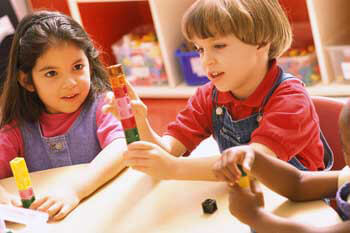3 Easy ways to turn any activity into a Social Activity
There are so many great cooperative activities kiddos can work on together but even independent activities can be social just by being mindful of a few details.
1. Placement of materials

This is hands-down the easiest and most overlooked environmental manipulation to get children to interact with one another. When are you really motivated to talk to someone? When you need something! Instead of having a caddy with all the materials for the project within reach of each child, separate the materials so that different supplies are within the reach of different children. This is great because it evokes intrinsic motivation to communicate. When one child realizes they need a green crayon and it's far away from them but near their peer, they will not only ask for it but also realize that using their peer’s name and gaining their attention first, will get their desired item to them even faster!
2. "Showing off" their work
Kids should be proud of the work they create and delight in showing it to others. Encouraging the child to get their friend's attention and show their work, ("Hey Joe, look at mine!") will not only get acknowledgement from a peer ("Cool!") but then lead the peer to counter by showing his masterpiece as well ("Look at mine!"). This establishes the peer as a positive presence in that child's world and increases the likelihood of continued sharing.
3. Desk arrangement
Are the children able to see each other or are they all just looking at an adult? Can they hear each other well? Are the desks or tables the right height? No one wants to be social when they are uncomfortable or have sensory overload. These are details that can significantly affect the quality of social interaction and should never be underestimated. Having desks or tables arranged so that the children have their personal space but also close enough to be heard when they ask or comment on the task will make socializing all the much easier.
